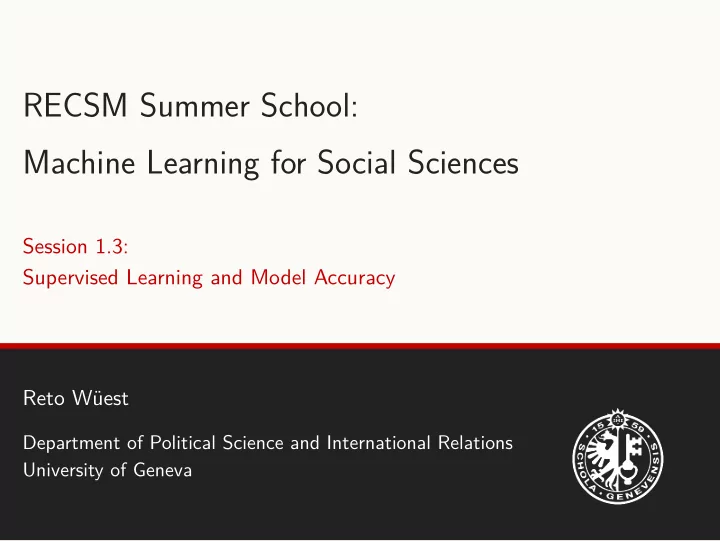

RECSM Summer School: Machine Learning for Social Sciences Session 1.3: Supervised Learning and Model Accuracy Reto Wüest Department of Political Science and International Relations University of Geneva 1
Supervised Learning
Supervised Learning Statistical Decision Theory
Statistical Decision Theory • Let X ∈ R p be a vector of input variables and Y ∈ R an output variable, with joint distribution Pr( X, Y ) . • Our goal is to find a function f ( X ) for predicting Y given values of X . • We need a loss function L ( Y, f ( X )) that penalizes errors in prediction. • The most common loss function is squared error loss L ( Y, f ( X )) = ( Y − f ( X )) 2 . (1.3.1) 1
Statistical Decision Theory • The expected prediction error or expected test error is expected test error = E ( Y − f ( X )) 2 . (1.3.2) • We choose f so as to minimize the expected test error. • The solution is the conditional expectation f ( x ) = E ( Y | X = x ) . (1.3.3) • Hence, the best prediction of Y at point X = x is the conditional expectation. • Let’s look at two simple methods that differ in how they approximate the conditional expectation. 2
Supervised Learning Method I: Linear Model and Least Squares
Linear Model and Least Squares • In linear regression, we specify a model to estimate the conditional expectation in (1.3.3) f ( x ) = x T β. (1.3.4) • Using the method of least squares, we choose β to minimize the residual sum of squares N � i β ) 2 . ( y i − x T RSS ( β ) = (1.3.5) i =1 3
Linear Model and Least Squares – Example • Goal is to predict outcome variable G ∈ { blue , orange } on the basis of training data on inputs X 1 ∈ R and X 2 ∈ R . • We fit a linear regression to the training data, with Y coded as 0 for blue and 1 for orange. • Fitted values ˆ Y are converted to a fitted variable ˆ G as follows if ˆ orange Y > 0 . 5 , ˆ G = (1.3.6) if ˆ blue Y ≤ 0 . 5 . • In the figure below, the set of points classified as orange is { x ∈ R 2 : x T ˆ β > 0 . 5 } and the set of points classified as blue is { x ∈ R 2 : x T ˆ β ≤ 0 . 5 } . The linear decision boundary separating the two predicted classes is { x ∈ R 2 : x T ˆ β = 0 . 5 } . 4
Recommend
More recommend